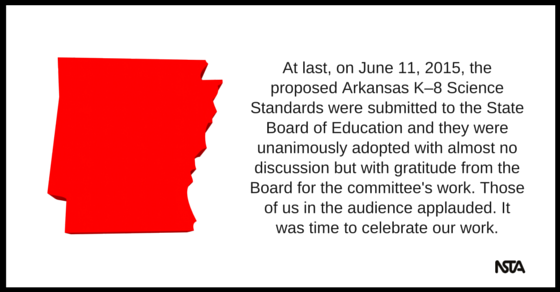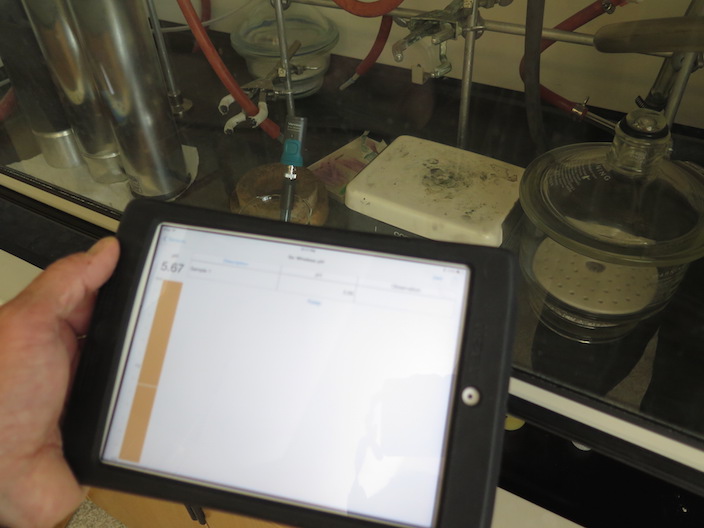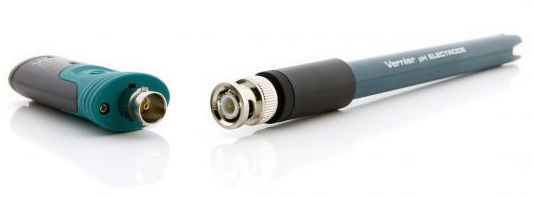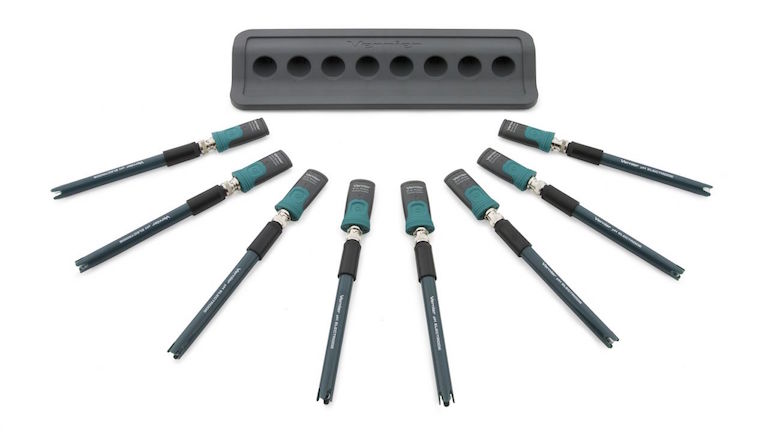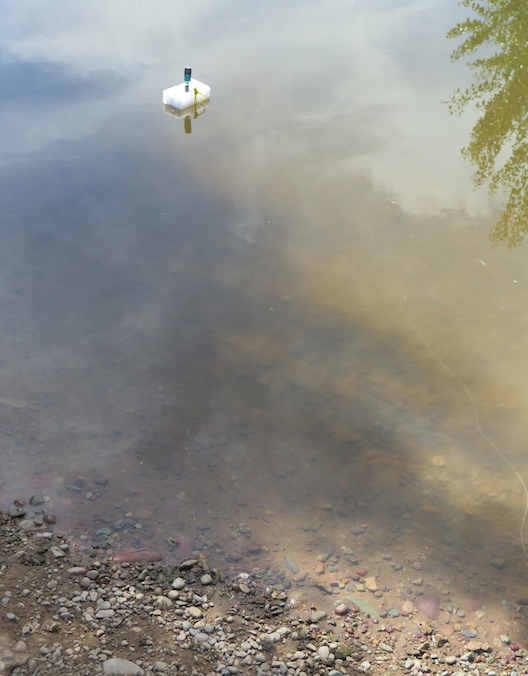Bruce Alberts’ Grand Challenges Offer Reforms Sought by Science Educators
By Robert Yager
Posted on 2015-06-24

Bruce Alberts, co-founder of the Science & Health Education Partnership, brings science to life in a San Francisco public school. UCSF Public Affairs file photo circa 1987.
Bruce Alberts grew up living near Chicago where his love of science started at an early age. He received a bachelor’s degree in biochemical science and a doctorate in biophysics. Alberts is best known for having served as President of the National Academy of Science (NAS) for 12 years. He is an advocate of improving science education in both primary and secondary schools. It is apparent that his daughter’s teaching has influenced Alberts as she continues teaching high school science in the San Francisco Public Schools.
Alberts also served for five years as Editor-in-Chief for the AAAS journal Science. As his service ended in 2013, he offered Three Grand Challenges for improving science teaching. The first Challenge was to encourage using the wisdom of teachers and education researchers alike. Specifically, it was to “Build education systems that incorporate the advice of outstanding full-time classroom teachers when formulating education policies.” Such teaching has been central to the NSTA Exemplary Science Program (ESP) monographs.
The second Grand Challenge offered by Alberts was to: “Harness the influence of business organizations to strongly support the revolution in science education specific in the 2013 Next Generation Science Standards.” He argued that we need more partnerships with business, industries, and education leaders across the world. Currently a major reform effort exists called STEM (Science, Technology, Engineering, and Mathematics) with innovations designed to prepare young people for future science careers. The NSTA publication Exemplary STEM Programs: Designs for Success illustrates how STEM reforms are being used to change science teaching at all levels (K-16).
The third Grand Challenge offered by Alberts was to: “Incorporate active science inquiry into all introductory college science classes!” Many college teachers are now accepting this challenge for improving college teaching. The STEM reform mandated exemplary science teaching should be approached without the typical use of textbooks, laboratory manuals, and teacher lectures. Such change is needed to exemplify evidence of real learning by students and not just their reciting what they remember from textbooks and lectures. Changing typical teaching methods used by college science faculty is one of the most needed changes (but hardest to achieve). College professors often are only interested in research and grant funding – not teaching!
Alberts urges all, especially scientists, to be active collaborators and to focus on teaching that improves student learning and use of the information that illustrates the real “doing” of science. This means exploring the natural universe, seeking explanations of the objects and events encountered, and seeking evidence to support the explanations proposed. All teachers should encourage students to focus on “doing” science as opposed to just reciting what they remember from textbooks and teacher lectures. Current reforms of science can be met by using the three “Grand Challenges” offered by Bruce Alberts. But as Alberts stated in 2013, “A start has been made, but much more remains to be done.”
Robert E .Yager
Professor of Science Education
University of Iowa
Classrooms as ecosystems: The physical environment
By Mary Bigelow
Posted on 2015-06-23
(This is a continuation of Classrooms as ecosystems: Social interactions, in response to a question about creating a classroom that is a positive place for learning:
 The physical environment
The physical environment
When I taught a graduate education class, I asked my students to provide visual tours of their classrooms with photographs and descriptions explaining why the room was organized the way it was: why the desks or tables were configured the way they were, what was on the bulletin boards and why, how materials were stored, where the teacher’s desk was positioned and why, and their wish lists on how the space could be improved. (I modeled the activity with my own classroom). This led to an interesting discussion on physical factors that affect learning and the types of activities that teachers and the students can do. This of course varies by age and subject area; an elementary classroom has different characteristics than a secondary science lab.
In general, you’ll want your classroom/lab to be physically conducive to learning: safe, comfortable, flexible, and attractive. Students should know that this is a science space (whether it’s an entire classroom or a science corner), with appropriate materials and organization.
Safe: Your classroom/lab should have appropriate safety features, running water, electrical outlets, and flat tables. If you’re teaching science in a regular classroom without these, you and the students are limited in what you can do. If an activity or investigation cannot be done safely, you can’t do it, regardless of how interesting it might be. (See the blog Lab Safety Question)
If you’re a floater (unfortunately a common assignment for new teachers), it’s very hard to get a sense of place with students. Every room will be different, and the teacher based there may be territorial enough to limit what you can do (Don’t write on the board, don’t use the projector, don’t move the desks, etc.). This situation requires planning and cooperation among teachers and administrators to ensure that all students have equitable opportunities in an appropriate facility.
Another aspect of safety is the amount of clutter. (We teachers are often pack rats; we never know when we’ll need something!) Storage space in classrooms and labs is often at a premium. But without a plan for organizing and storing materials, classrooms can become overwhelmed with stuff and become fire hazards, dust collections, and barriers to student movement and exits. The clutter is also distracting to students.
Comfortable: There should be enough flat-topped desks or chairs and tables for students to work. Students should have room to move around and spread out. Desks and lab tables should be the appropriate size for the students (this is sometimes a problem in middle schools that are repurposed high schools). The lighting should be adequate, especially in rooms where there are no windows.
Flexible: We’ve all seen pictures of schoolrooms with student desks bolted to the floor. While this might be a custodian’s dream come true, it’s not necessarily appropriate for a variety of learning activities. No one seating arrangement is best—each has advantages and disadvantages, depending on the learning activities. If you use a variety of instructional strategies in your class, you’ll want to use a variety of seating arrangements. (See the blog Classroom Seating Arrangements.)
Attractive: If there were a “Classroom Beautiful” magazine, I’m sure there would be many nominees for the cover. Many teachers spend hours each year planning and creating colorful bulletin boards. But what about student input? The classroom should belong to the students rather than serve as a shrine to the teacher’s interests or artistic abilities. (See the blog Displaying Science on Classroom Bulletin Boards and The Classroom as Learning Center.)
It is possible to have an attractive classroom that does not require much time or expense. You can set up a table with materials related to your current topics for students to examine (e.g., shell collections, animal bones, rock samples, weather maps, simple machines). Hand lenses and microscopes invite students to explore. A display of science trade books can brighten up a corner and encourage students to browse and learn.
Another component of an attractive classroom is organization—a place for everything and everything in its place. Having designated places for materials and de-cluttering is easier said than done in a classroom, but students can be part of this endeavor.
I’m sure your cooperating teacher works hard at creating and adjusting an effective and efficient learning environment. With careful planning, organization, monitoring, and reflective feedback, your new classroom ecosystem can facilitate learning as a joyous, exciting adventure.
(This is a continuation of Classrooms as ecosystems: Social interactions, in response to a question about creating a classroom that is a positive place for learning:
 The physical environment
The physical environment
Classrooms as ecosystems: Social interactions
By Mary Bigelow
Posted on 2015-06-23
 During my student teaching, I was impressed with how the classroom was a very positive place for learning. I wasn’t there at the beginning of the year when the teacher set things up, so I’m wondering what to do when I get my first classroom. —A., Massachusetts
During my student teaching, I was impressed with how the classroom was a very positive place for learning. I wasn’t there at the beginning of the year when the teacher set things up, so I’m wondering what to do when I get my first classroom. —A., Massachusetts
I’ve had the opportunity to visit scores of classrooms (elementary and secondary), each of which had its own atmosphere or “vibe.” Some were relaxed and joyful. In others you could cut the tension with a knife. Some had stability and order based on established routines. Others were chaotic or highly regimented. Some were safe, attractive, and conducive to learning, while others were cluttered, stark, or (in some cases) unsafe.
The positive environment you experienced did not happen overnight or by chance. Ask your cooperating teacher how she organizes the classroom before the school year starts. Pick her brain about the kinds of strategies she uses with students to provide the kind of environment you experienced.
Keep in mind that when you get your own classroom, you’ll have a unique combination of students, facilities, resources, school culture, and administrative requirements. No matter what (if anything) you inherit from your predecessors, from the very first day you will be the one who establishes the classroom environment. You’ll find your classroom evolving as you gain more experience and try new strategies and arrangements.
Rather than using a checklist of to-dos, it may help to consider your classroom as an ecosystem—interactions between the living and physical components of a place. As with an ecosystem in nature, the classroom will change with inputs to the system. An administrator may have new requirements, you might teach different subjects or grade levels, the students are different each year (or each class period), there will be changes in the curriculum and materials, and you’ll get new ideas from feedback, professional development, and your own reflections on your experiences. Even things like size, temperature, noise level, and time of day may influence interactions in the classroom.
In a classroom ecosystem there are living or social interactions between teacher–student and student–student. The type and quality of these interactions depend on the age of the student, the experience level of the teacher, and the personalities of all. The social components of the ecosystem (teacher and students) interact with the physical ones—the classroom’s physical layout, facilities, and organization. The teacher and the classroom may be in place for years, but the students change, every class period or every year.
The social environment
A well-organized and attractive classroom is not enough. The relationships between the people in the room are a key component in the classroom ecosystem. Establishing mutual respect, ownership, and routines is important to these relationships but takes time and effort on the part of both the teacher and students.
Respect: I could never identify with the cliché, “Don’t smile until Thanksgiving.” I genuinely liked my students and used the mantra “fair, firm, and friendly” as a guide. You can’t assume that students will know how to communicate respectfully or work cooperatively. They may need lots of modeling and practice.
Getting to know your students is a form of respect for their interests and individuality. This can be difficult at the secondary level where you come in contact with 100+ students every day. (See the blog Connecting with students).
Even on the first day of school, you’ll notice how each student brings a unique combination of knowledge, skills, and experiences to the classroom. As you get to know your students, use your awareness of their differences to enhance student engagement in learning activities. (See the blogs Everyone Gets a Chance and Organizing Students for Learning.)
Ownership: It is important for students to have a sense of ownership in both the physical classroom and in the learning activities. This requires the teacher to allow student input into the choice of classroom activities, classroom management, due dates for activities, and routines (keeping in mind that the ultimate decisions are made by the authority in the room—the teacher). Most students enjoy seeing their work displayed in the classroom, and this is an easy way to use bulletin board space. (See the blogs Displaying Student Work and Putting Science Words on the Wall)
Routines: Routines describe a desired way to perform everyday tasks. Having routines in place frees up more time to spend on important discussions and activities, rather than dealing with disciplinary or logistical issues. For example, for the beginning of class, post an agenda with what the students needed for the class (laptops, notebooks, textbook, pencil, assignments to turn in, and so on) so they can get ready for class (while they socialize a bit). “Bell-ringer” activities also focus the students’ attention. End each class with a summary and a preview of coming attractions before the students leave the room.
The procedures and routines are also a part of a safe learning environment. The ultimate goal of using routines is self-reliance: students know what is required and they have the skills to meet these requirements. With enough modeling and practice, students can internalize these so they know what to do without your giving specific directions. (See the blogs Chaos vs. Routines and Lab Management.)
See part 2–Classrooms as ecosystems: The physical environment
Photo: https://www.flickr.com/photos/ableman/334891088/
 During my student teaching, I was impressed with how the classroom was a very positive place for learning. I wasn’t there at the beginning of the year when the teacher set things up, so I’m wondering what to do when I get my first classroom. —A., Massachusetts
During my student teaching, I was impressed with how the classroom was a very positive place for learning. I wasn’t there at the beginning of the year when the teacher set things up, so I’m wondering what to do when I get my first classroom. —A., Massachusetts
How Arkansas Adopted the NGSS
By Guest Blogger
Posted on 2015-06-22
Last week Arkansas celebrated the adoption of the Next Generation Science Standards (NGSS) for K–8 students and work is ongoing for 9–12. We’ve had a strong connection with the NGSS since work began to develop them in 2011. Arkansas was designated as a Lead State along with 25 other states and we were fortunate to have two classroom teachers (Melissa Miller and Kathy Prophet) working as writers. I was fortunate to be selected as a Critical Stakeholder reviewer for the NGSS as they were being developed. In April 2014, the Arkansas State Board of Education voted unanimously to endorse the NGSS as the basis for the development of Arkansas’ new K–12 science standards. Based upon that action, the Arkansas Department of Education (ADE) under the leadership of Michele Snyder (ADE Science Specialist) assembled a team of over 40 stakeholders to begin the review and development of the K–8 Arkansas Science Standards. The committee included administrators, K–8 classroom teachers, university professors, science specialists, and other vital stakeholders. It was a diverse, committed, and talented group. ADE staff members in the assessment, curriculum, and technical departments were also present to assist the committee in its task.
The K–8 committee was divided into four teams and met on multiple occasions during the fall of 2014 and the spring of 2015. At the first meeting, the committee studied the basis for the NGSS, A Framework for K–12 Science Education (published by the National Research Council) and reviewed the NGSS, its three dimensions, and the appendices to build common understanding. At the second meeting, the committee began the difficult task of analyzing the student Performance Expectations in grades K–8. The committee chose to retain the existing NGSS K–2 standards untouched, and to add some Arkansas-specific clarification statements and assessment boundaries to the grades 3–5 PEs. Our greatest challenge came in assigning the grades 6–8 PEs to a specific grade level and writing a few Arkansas-specific clarification statements and assessment boundaries. We studied what previous NGSS-adopting states had done in assigning PEs and used that information to guide our work. Then using the committee’s work, the ADE produced three different models for the K–8 standards. The final meeting was laborious as the committee ultimately came to consensus on the Arkansas K–8 Science Standards by choosing the best pieces from all of the models and setting the format and numbering system for the Arkansas PEs based on the NGSS.
The ADA placed the Arkansas K–8 Science Standards online for a 30-day public comment period. Notifications were sent to schools and teachers state-wide so that interested parties could read the proposed standards and offer comments. We were pleased to see that over 80% of the comments received were supportive and favorable of the new standards! A small team of the K–8 committee met in early June to read and respond to all of the comments made during the public comment period and we made needed changes based on public comments. At last, on June 11, 2015, the proposed Arkansas K–8 Science Standards were submitted to the State Board of Education and they were unanimously adopted with almost no discussion but with gratitude from the Board for the committee’s work. Those of us in the audience applauded. It was time to celebrate our work.
We have now started work on the Arkansas 9–12 Science Standards. Our first meeting was in mid-June and I expect the development process to be similar to the work of the K–8 committee. I have enjoyed working with and learning from my colleagues while serving as an advisor for the committee. We hope to have a 9–12 standards proposal ready for public review and comments in early 2016 with submission to the State Board of Education for approval in the spring of 2016.
Arkansas has planned for a coordinated implementation of the new science standards. Professional development is required for teachers to become familiar with the conceptual shifts in science teaching that will need to be made to help students meet the expectations of the new Arkansas K–8 and 9–12 Science Standards. The grades K–4 standards will take effect in 2016–2017, and the grades 6–8 standards will be implemented in 2017–2018. When adopted, the 9–12 standards would take effect in 2018–2019.
To access resources and stay up-to-date on all developments regarding the adoption and implementation of the NGSS, in Arkansas and elsewhere in the United States, please bookmark the NGSS@NSTA hub. There, science teachers have access to general NGSS information, the standards by topic, curriculum planning guidance, vetted classroom resources, professional learning opportunities, and NGSS news.
 Steve Long teaches Pre-AP Chemistry, and ChemCom at Rogers High School (RHS) in Rogers, Arkansas, where he has worked for the past 25 years. Long is serving as an advisor to the Arkansas Department of Education assisting with developing the new Arkansas K-8 and 9-12 science standards.
Steve Long teaches Pre-AP Chemistry, and ChemCom at Rogers High School (RHS) in Rogers, Arkansas, where he has worked for the past 25 years. Long is serving as an advisor to the Arkansas Department of Education assisting with developing the new Arkansas K-8 and 9-12 science standards.
The mission of NSTA is to promote excellence and innovation in science teaching and learning for all.
Follow NSTA
Va-cation, stay-cation, and edu-cation
By Mary Bigelow
Posted on 2015-06-21
 But teachers get the summers off!! How many times do we see that in op-eds and online conversations? Those who make that comment obviously have never been a teacher, a family member of a teacher, or friend of a teacher. As a teacher, I never had a summer “off.” My classes did not end until the middle of June, I spent time reorganizing materials, revising lessons, and getting the lab in order. And then we started up again in August with inservice and work days to prepare for the first day of school, which started the week before Labor Day.
But teachers get the summers off!! How many times do we see that in op-eds and online conversations? Those who make that comment obviously have never been a teacher, a family member of a teacher, or friend of a teacher. As a teacher, I never had a summer “off.” My classes did not end until the middle of June, I spent time reorganizing materials, revising lessons, and getting the lab in order. And then we started up again in August with inservice and work days to prepare for the first day of school, which started the week before Labor Day.
So what do teachers do on their “days off”? Even on family vacations (Did you ever forget yourself and call them “field trips”?), we’re always looking for ideas and resources for our classrooms. You can tell who the teachers are at amusements parks (figuring out the physics principles at work), on the beach (identifying shells and other critters), and on the hiking trails at state and national parks (with binoculars and guidebooks). We take our families and friends to museums, planetariums, science centers, zoos, nature centers, botanical gardens, and arboretums. In our beach bags or backpacks, we might pack a mystery or romance novel, but we’re very likely to include science-related nonfiction and professional books and journals. Even at historical sites, we look for applications of science to share with our students (for example, while my husband and I were touring and exploring the history of the Gettysburg Battlefield, I was also photographing the lichens on the monuments and birdwatching on Little Round Top). We stop the car to photograph interesting rock outcrops or fantastic cloud formations. Our souvenirs include rocks, sand samples, fossils, pressed wildflowers, maps and brochures for bulletin boards, books for classroom libraries, photographs for our lessons, and thoughts and reflections about improving what we teach. (SciLinks: Amusement Park Physics and Roller Coasters, U.S. National Parks, Identifying Trees, Identifying Rocks and Minerals, Clouds, Science of Surfing, Water Safety)
For teachers, a stay-cation often involves teaching summer school, working on curriculum updates and new lessons, graduate classes, workshops, webinars, independent study, and using social media to form professional learning communities (see the NSTA discussion forums, e-mail listserves, its Facebook presence, and #NSTA on Twitter). As NSTA members, we can access all of the journals, so summer is a good time to catch up on what’s happening at other grade levels: Science & Children, Science Scope, The Science Teacher, and the Journal of College Science Teaching. See NSTA Recommends for even more print and online suggestions. To brush up on or learn new topics, NSTA’s Science Objects are self-study units related to content, and they’re free to anyone.
On my summer list is to continue to use the NGSS@NSTA hub with just about everything there is to know about the Next Generation Science Standards. The site includes classroom resources, videos of aligned lessons, curriculum planning ideas, professional learning opportunities, and access to the standards themselves. I’m really interested in the new enhanced eBook Discover the NGSS: Primer and Unit Planner with “interactive activities, assessments, demonstrations, videos, beautiful images and concrete examples that explain and will foster a deep learning and understanding of the science standards.”
Too many books and e-resources, too little time!
It would be interesting for us to collectively document the time we spend, the topics we investigate, and expenses we incur during the summer as we update our knowledge, skills, and classroom resources. We could show the public that most of us educators spend a great deal of our summers on edu-cation.
(updated from June 2011)
Photo: MLB
Garden observations and questions
By Peggy Ashbrook
Posted on 2015-06-20
 Gardening with children may turn up questions voiced by the children or suggested by their behavior. As you observe children in the garden or a natural area, take a few notes about what they look at or touch. Model how you wonder about a phenomenon in the garden by saying it aloud, such as, “Is this sprout taller today than it was yesterday?” Not all questions can be investigated by children. “Why are most leaves green?” is a question that can be researched in books or online, but not investigated by young children. Children can investigate “Are there any leaves that are not green?”
Gardening with children may turn up questions voiced by the children or suggested by their behavior. As you observe children in the garden or a natural area, take a few notes about what they look at or touch. Model how you wonder about a phenomenon in the garden by saying it aloud, such as, “Is this sprout taller today than it was yesterday?” Not all questions can be investigated by children. “Why are most leaves green?” is a question that can be researched in books or online, but not investigated by young children. Children can investigate “Are there any leaves that are not green?”
The December 2010 issue of Science and Children addresses questions in many articles. Linda Froschauer, Field Editor of Science and Children, writes in the Editor’s Note “Investigable questions are important elements of lessons that promote inquiry and help students construct meaning. Good questions help students make links between what they know, what they want to find out, what they observe, and how their observations fit within the context of their learning and development.” Asking questions, and planning and carrying out investigations, are two of the Science and Engineering Practices identified in A Framework for K-12 Science Education, one of the foundational documents for the Next Generation Science Standards.
 Here are some other questions that children can investigate in a garden:
Here are some other questions that children can investigate in a garden:
Do all vines go around a pole in the same direction?
Do day lily flowers close up at a certain time in the evening or do they stay open longer if they are in bright light indoors?
 Why are there holes in this leaf? Is something eating it?
Why are there holes in this leaf? Is something eating it?
 What happens to a leaf when rain falls on it?
What happens to a leaf when rain falls on it?
“Where are seeds made?” is a question to investigate over time by making observations of more than one plant.  While drawing a plant in the garden children may notice more than when walking through the space. A simple “journal” of a sheet of paper folded in quarters and a marker are all the materials needed to give children time to observe and think about what’s happening in a garden.
While drawing a plant in the garden children may notice more than when walking through the space. A simple “journal” of a sheet of paper folded in quarters and a marker are all the materials needed to give children time to observe and think about what’s happening in a garden.
Engineering the Next Generation Science Leaders in Omaha
By Guest Blogger
Posted on 2015-06-13
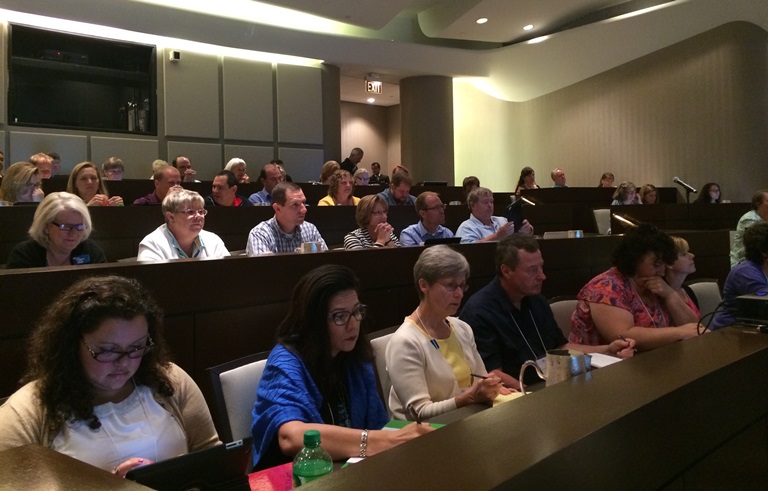
Omaha, Nebraska, is the destination of the upcoming 2015 National Congress on Science Education (July 15-18, 2015). Leaders and members of Chapters and Associated Groups along with the NSTA leadership will gather to discuss science education issues that are relevant to promoting excellent science teaching and leadership. The theme of this year’s Congress is “Engineering the Next Generation of Science Leaders 2015.”
The NCSE planning committee developed the program utilizing the new NSTA Strategic Goals. Using the strategic goals, state leaders will be empowered to develop more effective organizations and networks. An important component of Congress includes the issue forum sessions where attendees will collaborate on ideas addressing the issues. The three issue forums are: Chapter/Associated Group Leadership and Advocacy, Professional Learning, and Elementary Science Education. Resolutions may be written from each of the issue forums to help direct both NSTA and Chapter/Associated Groups in their work. In addition to collaborating within the issue forums attendees will have the opportunity to network through workshops led by other NSTA members focusing on social media and technology integration, instructional strategies, organization management, fiscal responsibilities, the NSTA Learning Center, NGSS and NSTA resources. A new feature this year is the “unconference.” This is an opportunity for those attending Congress to determine the break-out sessions and step-up as a facilitator for the session. In addition to networking opportunities, the attendees will hear from speakers that include Stephen Pruitt, Jodi Peterson, and the five awardees of the Yager Foundation Excellence in Teaching Award.
Congress is a wonderful setting to build relationships and network with other NSTA groups and members. When attending an event like Congress I always came away with new ideas that I could take back to my state organization. There is not enough time in the day to try and create new ideas when I could learn from the successes of other NSTA chapters and associated groups. Congress was my professional learning for growing my state organization.
So don’t delay! There is still time to register for the 2015 NCSE. Go to the NCSE webpage for more information about Congress and how to register. Note: June 15 is the last day to declare a delegate from a chapter or associate group.
So come – network, collaborate, celebrate and be creative – as we “… promote excellence and innovation in science teaching and learning for all.”
See you in Omaha!
Carolyn Hayes is NSTA President, 2015-2016; follow Carolyn @caahayes or use #NSTACongress for updates.
The mission of NSTA is to promote excellence and innovation in science teaching and learning for all.
Follow NSTA
NSTA at NAESP: Hands-On Science + Literacy Solutions
By Lauren Jonas, NSTA Assistant Executive Director
Posted on 2015-06-11
The 2015 annual conference for the National Association of Elementary School Principals (NAESP) takes place June 30–July 2. Designed for educators on the front lines — teachers, superintendents, counselors, district and state administrators, and especially principals — the conference aims to have a huge impact on student success. And the National Science Teachers Association (NSTA) will be there to join them as principals experience the future of education.
NSTA’s position on Elementary School Science states “we support the notion that inquiry science must be a basic in the daily curriculum of every elementary school student at every grade level.” And we believe that science is a key component of a complete and rigorous curriculum for all students. Supported by our community of expert educators with a solid science education background and a passion for literacy, we’ve assembled a powerful resource collection that helps integrate science and literacy at the elementary level. Join us in Long Beach, California, June 30–July 2 to learn more, and stop by our booth to share your ideas with us about the direction in which you see education going.
When you do visit us, whether onsite or online, we hope you will sample some of our resources:
- Professional journals, packed with science teaching techniques, lessons, and activities
- Classroom-tested tools for integrating science and literacy in elementary classrooms
- Formative assessment strategies that thousands of educators are using now
- Quick reference guides to NGSS implementation
- NSTAKids books… fun for kids, accurate science for teachers
Visit booth #1123 onsite or use promo code NAESP online at the NSTA Science Store to receive the same 20% discount on all NSTA Press publications* that our members get—plus $5 off NSTA membership for yourself or a science teacher on your team!
*Offer good only on NSTA Press publications, from June 29–July 10, 2015, and cannot be combined with any other offer or discount.
The mission of NSTA is to promote excellence and innovation in science teaching and learning for all.
Follow NSTA
Go Big with Vernier's Go Wireless pH Sensor
By Martin Horejsi
Posted on 2015-06-10
Go Big with Vernier’s Go Wireless pH Sensor
Dethethering is a fancy word for eliminating the cord. By going wireless the probe opens some interesting doors to creative and safe exploration and experimentation. One of the big advantages of a wireless probe is the same advantage we experienced with telephones and microscopes went cordless. No longer did we trip over cords, knock over containers when moving the cords, or dredging off the top of counter tops desks with the cord acting like a giant chain stripping the surface down to bare ground.
Goal-setting
By Mary Bigelow
Posted on 2015-06-09
 Our new principal wants us to come up with goals to accomplish in the next year. He hasn’t provided much guidance yet, so I don’t know what to do. How can I do this meaningfully? —J., Delaware
Our new principal wants us to come up with goals to accomplish in the next year. He hasn’t provided much guidance yet, so I don’t know what to do. How can I do this meaningfully? —J., Delaware
The end of the school year is a good time to reflect. This often leads to developing professional goals to improve your teaching and student learning. You probably have some in mind.
Working toward these goals can be an effective part of an individualized professional development plan. Unfortunately, goal setting is often an empty formality in my experience. I would definitely talk with your principal about his expectations.
I had a principal who required us to submit several goals each year. I suspect it was something he felt he had to do (or was told to do), but he did not provide any suggestions or examples on the number, format, or purpose. And he did not follow up on them during the year. Our professional development was not based on the goals, and they were not mentioned during any post-observation conferences. Because of this, I didn’t take the goal setting process seriously, treating it as a yearly task to check off the list. I certainly worked at becoming a better teacher, but those efforts were not formally related to the goals I submitted.
The process was different at another agency I worked for. Everyone, including the executive director, used the agency’s mission statement to formulate two to three SMART goals (the format is described below). We fine-tuned them with our supervisors and created an action plan to address them. At the mid-term and end of the year we discussed our progress and how the process was adding to our professional growth. It was a powerful form of professional development and a positive experience in reflection and self-evaluation.
Looking back, I realized my school district goals, as they were written, were not useful because they were extremely broad and lacked much purpose. The SMART acronym describes a more focused format:
- Specific: The goal is clearly stated with what you want to do, why it is important, and how it will be accomplished.
- Measurable: The goal describes the evidence you’ll use to determine your progress.
- Achievable: The goal is doable and realistic, given the resources that are available to you.
- Relevant: The goal relates to student learning and performance.
- Timely: The goal has target dates for achievement.
For example, “I want students to participate in class discussions” is a worthy but broad goal. It can be tweaked into a SMART goal:
- Specific: I will improve student learning by promoting active participation, using three strategies: calling on students randomly, using wait time, and incorporating turn-and-talk discussions.
- Measurable: I will use class observations (tally sheet of participants) as well as formative and summative assessment results.
- Achievable: The strategies require no additional resources or materials. I will read more on these strategies in professional publications.
- Relevant: The goal addresses student learning through equitable participation.
- Timely: The trial is one semester.
Here are some generic goal areas that could evolve into SMART goals:
Instructional Goals
- Incorporate inquiry into more lessons.
- Use strategies and assessments that focus on higher-level learning.
- Incorporate science notebooks.
- Implement new technology for ____.
- Prepare better substitute plans.
- Use a variety of formative assessments.
- Design lessons/units aligned with the Next Generation Science Standards (NGSS).
Interpersonal Goals
- Improve teacher-parent relationships, focusing on positive communications.
- Build better relationships with colleagues and other staff.
- Get to know students better.
Organizational Goals
- Establish routines for accessing and returning lab materials.
- Establish and maintain a classroom management plan, including expectations, routines, and rules.
- Improve documentation for various classroom situations.
- Keep up with inventories and other paperwork.
- Keep a record of lessons and units and put together notebooks or electronic files for each unit.
NSTA has a wealth of professional resources to help you meet your goals: online discussion forums and email lists, journals, books, conferences, the NGSS@NSTA Hub, free web seminars, and content-based courses.
Photo: https://www.flickr.com/photos/eclectic-echoes/6681499071/


